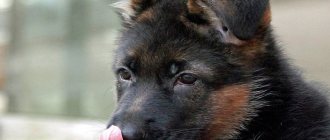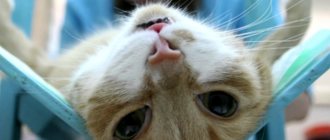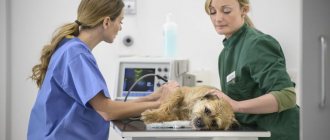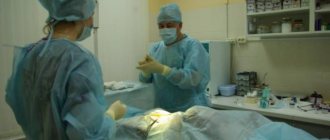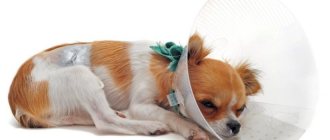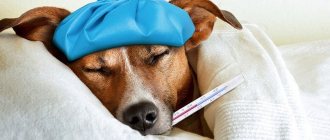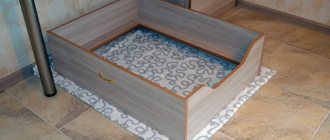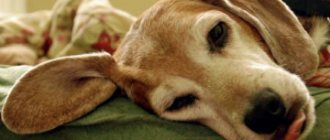Recovery of a male dog after castration: how to care for your pet after surgery
Castration is one of the most common operations in a veterinary clinic.
Doctors constantly repeat that this is an easy, low-traumatic procedure that will not cause any trouble to the dog. But how does a male dog actually recover after castration? Do I need to leave my pet in the hospital and for how long? I personally encountered the fact that owners were ready to stay at home on their next vacation to care for their pet after surgery. They were very worried whether there would be complications. This couple called me almost every day to tell me how Tyson ate, pooped, took off his collar, and walked. This began to irritate me, because the dog was young and healthy, the operation went perfectly, I gave detailed written recommendations. Now I'm ashamed of myself. The owners of that Chihuahua were puzzled by one thing - the welfare of the dog. And how do they really know what is normal and what is not? General anesthesia and stitches can be scary and confusing when you've never experienced it before.
Therefore, in addition to the article about the pros and cons of castration of a male dog, I wrote this “guide”. How should the dog’s recovery proceed, and what complications are possible.
—>
Types of castration
Let's look at several methods of castration. Most often, the veterinarian performs surgery to remove the testes. Neutered pets are safer than unneutered ones who live outside and run freely around females.
For example, transmissible sarcoma is sexually transmitted. This is a tumor in which foul-smelling cancerous growths grow on the mucous membrane of the genital organ. And this type of cancer is transmitted only through sexual contact.
The dog is given anesthesia, which is called general, and he falls asleep soundly. The animal, which lies on its back, is fixed by stretching and tying its front and hind limbs. Using antiseptics, the incision site is carefully treated.
Let's look directly at the technique and how the operation is performed:
- In an open way. The scrotal wall is grasped above the testis and an incision is made (along the middle seam). Now you need to open the tunica vaginalis and pull out the testis by pressing. The veterinarian will divide the mesentery in the testis, the vas deferens along with the vessels will be ligated using two or one ligatures. 2 the testis is pulled out with the same incision, the area is covered with subcutaneous tissues and skin;
- In a closed way. The skin of the scrotum is cut and the vaginal sac is taken out so that you can see where the cord is located and what is in the cavity is taken out. The spermatic cord is released from the fascia located outside and ligated. 2 testes are cut and the same is done. All that remains is to cover the operated area with subcutaneous tissues and skin.
How does castration of a male dog occur?
The technique for castrating male dogs differs from castrating rabbits or cats; these operations cannot be compared. There is only one general point: if both testicles are in the scrotum (the male is not cryptorchid), then castration is not an abdominal operation.
Why, why are we going to the clinic?
A very important point: the surgeon should not cut the skin of the scrotum. There are many nerve endings and even more blood vessels. The incision is made “along the white line” in front of the scrotum, and both testes are brought out through it. A ligature is applied to the feeding vessel and the spermatic cord, and it slips into the pelvic cavity. The skin wound is sutured.
The suture can be cosmetic (all the threads are inside the skin, gradually dissolving) or removable, external. This depends on the qualifications of the surgeon, the availability of suture material, and also on how the operation goes. I never tell owners in advance what exactly there will be “cosmetics”. It happens that the skin is too loose and separates; sometimes it is necessary to “press” the bleeding vessel of the skin with the external sutures. If removable sutures are placed carefully, they will not create any problems.
The entire operation lasts about 15-20 minutes. But the dog will stay in the operating room longer. This is due to the fact that you need to shave, wash and disinfect the skin, isolate this area with the surgical field, and administer local anesthesia. After the operation, wait until the patient begins to wake up. Only then is the pet taken out to its owners - or placed in a cell in a hospital. How is it accepted where?
Coming out of anesthesia: what to pay attention to
You will have to write a separate article about the types of anesthesia. Therefore, there are no uniform recommendations. After gas (inhalation) anesthesia, the dog will be given to you almost fully conscious. If intravenous anesthesia (propofol) was used, then the animal also comes to its senses within half an hour.
Intramuscular anesthesia is another matter. If you do not use a special drug that brings the dog out of anesthesia (Antisedan, Antimedin, Alzan), then the animal will be “drunk” for a long time. It is precisely such an unconscious patient that needs constant supervision.
Labrador recovers from anesthesia
Do not try to immediately pick up your pet. If the dog is still sleeping, it is much safer to lay it on a flat surface, on its side. Doctors pull the tongue out of the mouth, hanging to one side. It can be moistened with a wet hand to prevent it from drying out. When waking up, vomiting may begin, although with a proper fasting diet it almost never happens.
The dog should breathe evenly and deeply. Breathing should be monitored especially carefully in brachiocephalic breeds. In a bulldog or pug, a long velum palatine may block the entrance to the trachea. A half-asleep pet will quietly gasp, and only by the purple color of its tongue will the owner understand that it’s time to sound the alarm.
Waking up from anesthesia, the dog may behave absolutely inappropriately - not recognizing the owner, biting the hand that strokes his face. Some dogs begin to bark and whine, not because they are in pain, but because the nervous system is excited.
The dog will try to get up, fall, and kick its legs. It is very important to prevent injury. Do not place your pet on a slippery floor and encourage activity. The dog is calmed with a voice and sat down, not allowed to rush around. Decorative dogs are carefully picked up.
Large dogs are laid to sleep on the floor
If the clinic's capabilities allow, owners should not be left alone with a pet that has not fully recovered from anesthesia. He must be supervised by staff.
The first day after surgery
Regardless of what anesthesia was used, the dog's body temperature decreases during the operation. The smaller the dog, the more it cools down. If the clinic uses special heating pads, that’s wonderful, but even after waking up, it’s very important to make sure your pet doesn’t get cold. Be sure to bring a warm fleece blanket to wrap or cover your dog. Feel your paws and ears - how cold are they?
Create a cozy nest at home and eliminate drafts. Warmth and peace are the best conditions for a male dog’s recovery after castration.
You cannot leave your dog on the bed/sofa! Coordination of movements after anesthesia may be impaired, which can lead to injury. Only on the floor!
Labrador recovers after castration
There is no need to rush to water or feed your pet, and even more so, you should not force something into the mouth. Let the water be freely available; if he wants, he can drink. Your doctor will tell you when you can feed; recommendations differ depending on what kind of anesthesia was used. The minimum fasting diet is 4 hours (after inhalation anesthesia), 6-8 hours after intravenous anesthesia, and 10-12 hours after intramuscular anesthesia.
Give your pet not a full portion, but a quarter. If he doesn't vomit within an hour, feed another quarter. It's enough. You can give a full portion at the next feeding.
The main rule is no exotic delicacies. Wanting to console or pamper the dog, owners sometimes buy expensive canned food or allow him to eat a piece of sausage. The only thing you will achieve is disruption of the digestive system. Food should be familiar. If he ate dry food, let him eat it, there is no need to soak it. The pet's testes were removed, not his teeth.
On the first day, walks are purely sanitary in nature. We peed and pooped and went home. Until the stitches heal, the dog is kept on a leash. Playing with other dogs and active games should be postponed.
Scrotal swelling
If there are no medical indications, then the scrotum is not removed during castration of a male dog. Immediately after surgery, this leather pouch remains empty. Doctors may briefly apply a heating pad with ice to the scrotum to cause the blood vessels to constrict.
Don't worry about the aesthetic side of the issue - in a few months the skin will magically tighten. There will be a smooth place where the testicles were.
Bulldog after castration
True, this takes time. But the body does not tolerate any emptiness and strives to fill it. Therefore, lymph can accumulate in the scrotum. On the third or fourth day, it looks as if the testes have returned to their place! This is fine.
Sometimes the swelling can be too strong and painful. This happens in several cases:
- Blood clots had accumulated in the scrotum because a vessel was damaged and not ligated.
- The wound became infected and inflammation began.
- Rejection of the suture material occurs (the latter situation is extremely rare; usually the problem is a violation of sterility).
In which case should you see a veterinary surgeon as soon as possible:
- the scrotum is purple or bluish in color;
- the swelling is so strong that the scrotum is larger in size than before the operation, the skin is stretched;
- discomfort when walking in a dog, signs of pain.
The doctor may prescribe novocaine blockades with an antibiotic or systemic antibiotics; sometimes surgical revision of the wound is required (under local anesthesia).
This Labsky (Labrador and Husky mix) was neutered at 7 months.
You can see more photos of Labski (link will open in a new tab)
Caring for sutures after castration of a male dog
I do not prescribe any suture treatment after castration of a male dog. The less people go there, the better. This statement is true for a cosmetic seam. It should not be filled with iodine or brilliant green, so as not to burn the edges of the skin. The maximum that can be recommended is to apply an antiseptic spray that creates a protective film (Aluminium, Alu-spray, Second Skin) once every 2-3 days. But it is not advisable to buy it for two or three treatments.
Dalmatian recovers after surgery
If skin sutures are applied, they need care. But also careful, without fanaticism. The owners' task is to ensure that the threads do not stick to the skin or to each other. To do this, it is enough to wipe the seam once a day with an aqueous solution of chlorhexidine, removing the crusts.
Sometimes it is prescribed to treat the seam with iodine, but then a 5% alcohol solution is diluted 1:1 with boiled water or saline.
Before removing the sutures, you do not need to apply any ointments to them, unless the ointment has been prescribed by a veterinarian. You can be confident in the healing properties of panthenol or levomekol, but the ointment base itself is not suitable for treating seams.
While the skin is healing, you should not bathe the dog. If your pet splashes into a puddle while walking and dirt gets on the seam, you need to thoroughly rinse it with chlorhexidine or an aqueous solution of furatsilin (a tablet in a glass of boiled water).
Possible complications in a dog after castration surgery
Sometimes complications can occur after castration of a male dog, but they are rare. The main thing is to strictly follow the rules of care and recommendations of a veterinarian. True, breeders note that after the operation the following problems may occur:
- in the first 3-4 days the animal may have problems with defecation. To solve this problem, you should review your pet’s menu. He needs to be fed only liquid food, you can also give puree;
- there is disorientation in the area, but it usually goes away the next day;
- mild nausea may occur, especially during the period when the animal recovers from anesthesia;
- loss of appetite;
- general weakness;
- drowsiness or restless sleep.
These are common symptoms that usually go away on their own without medical intervention. However, suppuration and inflammation of the wound may occur, and the animal may also have a fever, pain when walking, or a suture rupture. In these cases, you should immediately contact your veterinarian.
When can you remove the collar after castrating your dog?
Avoiding suture licking is the most important recommendation you will receive from your veterinary surgeon. After castration, it is enough for bitches to wear a blanket. But the area where the seam is located after castration of a male dog is almost impossible to cover with cloth. The panties are instantly removed and also interfere with the need to relieve oneself.
The Pomsky looks amazing in these briefs, but they won't help protect the seam!
There are special post-operative tights - they fit tightly to the body and have an opening for the penis. But the collar remains the most reliable means of protection.
Special blanket for males
Collars vary in quality and materials. Before the planned operation, you can choose the appropriate model and size yourself. Plastic cones are not expensive, but large dogs can break such a “decoration”.
This beagle looks very unhappy in his collar.
Padded collars are more comfortable for the dog, but are rarely found on sale.
Postoperative pad collar
The collar must be on the dog 24 hours a day! Myths about the healing properties of dog saliva sometimes cause owners to ignore doctor's instructions. They feel sorry for the dog. But after the licked seams fester and fall apart, the “pathetic” instantly moves into the bee’s ass. After all, then the wound will take several times longer to heal; daily treatments and a course of antibiotics will be required.
Double protection: collar + tights
If after castration the doctor applies skin sutures, then the collar must be worn until the sutures are removed (usually 10-12 days). After the doctor removes the threads, he will assess the condition of the seam and tell you how many more days to wear the cap. Usually it takes another 1 day for the holes from the threads to heal.
If the stitch is cosmetic, then in the absence of inflammation, 7-10 days are enough for complete healing.
The collar must not be removed until the stitches are removed!
I often hear “he doesn’t lick there at all,” “he can’t reach it,” “I’ll look after him.” As much as veterinarians like to prescribe the wearing of a protective collar, owners resist it just as stubbornly. No need. Be patient for a week of strict regime and then forget about it forever.
If you are not scheduled for a follow-up appointment, then you decide for yourself when to remove the collar. Remove when you see pink, healthy skin at the suture site. The seam should be dry and clean, and the fur should already begin to grow back.
The doctor examines the postoperative suture
You need to look after your pet most closely for 3-4 days after surgery. At this time, the shaved areas of the skin begin to itch, the seam itself itches as it begins to heal, plus the scrotum swells.
Dog castration
If you do not plan to get puppies from your dog, the easiest way for effective treatment is to castrate the animal. The operation is performed under general anesthesia; the pet must not be fed for 12 hours beforehand. To remove the testes, a small incision is made on the scrotum; after their removal, sutures are applied, which are removed after 8-10 days if the condition is normal. After surgery, swelling is observed for several days. For orchitis, in some cases for healthy dogs, antibiotics are prescribed after castration. If discharge or bleeding begins after the operation, you need to show your pet to a doctor.
Castration of male dogs is easy, and later reveals extremely favorable consequences: the dog becomes less aggressive, life expectancy increases, he stops reacting to bitches in heat, and does not get involved in fights.
Do you need medications and what kind?
Only the doctor who performed the operation can prescribe medication for a male dog after castration. Sometimes I don’t prescribe anything - if the dog was young and the incision turned out to be tiny. At the clinic, the dog receives a painkiller that lasts for 24 hours and a long-acting antibiotic. If the operation was performed in a sterile operating room, this is enough.
If castration was performed for medical reasons (for example, prostatitis), or there was an intervention in the abdominal cavity (cryptorchid), a course of antibiotics may be required.
Painkillers are also prescribed at the discretion of the doctor for the first 1-3 days after surgery.
Most dogs show no signs of pain after surgery
Postoperative complications
Bleeding occurs primarily due to surgeon error or is associated with poor blood clotting in the dog. Prolonged internal bleeding leads to the death of the animal. The pet shows signs of acute anemia: trembling, rapid breathing, rapid pulse, pale mucous membranes. If blood enters the scrotal cavity, a hematoma develops, the treatment of which will require additional surgery. External bleeding is determined by local signs.
Slight swelling of the scrotum is a normal reaction of the dog’s body to surgical trauma. Inflammatory edema appears 3-4 days after castration. If your dog has a fever or pain when examining the scrotum, consult a doctor immediately.
Occurs when the postoperative wound is treated incorrectly and hygiene rules are not followed when keeping the animal. The dog can spread the infection itself by licking the seam. If redness of the skin, tissue swelling, or rash appears, the veterinarian will prescribe a course of antibiotics.
If the rules of asepsis and antisepsis are not followed during the operation, an infection gets into the wound, which progresses over time. The animal's temperature rises, appetite decreases, thirst increases, and apathy develops. Purulent or bloody discharge from the suture is possible. In this case, antibiotic therapy is used. A repeat operation is performed to remove the source of infection.
Swelling after castration
Edema after castration is a complication after removal of reproductive organs in domestic and farm animals. This is a peculiar reaction of the body to injury; it occurs due to the penetration of infection into the wound, leading to the formation of an inflammatory process. In veterinary medicine, there are two types of post-castration edema - limited and diffuse. In the first case, the inflammation spreads only to the scrotum. With diffuse edema, the inflammatory process affects the ventral wall of the abdomen and the foreskin.
Complications arising immediately after castration of males
disorders of the respiratory, cardiovascular and nervous systems can occur at any time during anesthesia. Below are the most common complications encountered at various stages of anesthesia.
6.1. Complications during induction of anesthesia
Respiratory and gas exchange disorders can occur due to anatomical damage to the oropharynx, aspiration of foreign bodies, malfunction of anesthesia equipment, etc.
The main signs of airway obstruction are:
paradoxical breathing, which manifests itself in the retraction of the intercostal spaces, increased movements of the anterior abdominal wall, the participation of auxiliary muscles in breathing, the appearance of noisy breathing, the sensation of an obstacle in inhalation; rapidly progressing cyanosis.
With hypoxia, cyanosis, tachycardia, initially an increase and then a decrease in blood pressure, dilated pupils, convulsions, bradycardia and cardiac arrest are noted. The causes of hypoxia are insufficient oxygen in the gas-narcotic mixture, pulmonary pathology, and anemia.
Hypercapnia occurs during anesthesia, when the lungs are not sufficiently ventilated (the volume of the administered gas-narcotic mixture is incorrectly selected) and carbon dioxide is not completely removed. At the same time, blood pressure increases, salivation and bronchorrhea intensify, and a purplish-red color of the mucous membranes appears. Hypercapnia leads to increased bleeding, which manifests itself during surgery.
Airway obstruction can occur due to injuries: damage to the jaws, tongue, teeth, trachea. In these cases, a tracheostomy should be immediately applied and anesthesia administered through it. The cause of obstruction can be foreign bodies (most often bones, splinters, etc.). Foreign bodies should be removed; if this fails, tracheostomy should be resorted to.
Severe complications may occur when vomiting or regurgitation of gastric contents occurs. Vomiting is usually preceded by hypersalivation, tachycardia, and respiratory rhythm disturbances. Regurgitation may go undetected and therefore become a more dangerous complication. The entry of gastric contents into the lungs leads to the development of aspiration syndrome. In this case, not only mechanical obstruction of the airway occurs, but also, due to the intake of acidic gastric contents, laryngo- and bronchiolospasm, a burn of the mucous membrane of the tracheobronchial tree occurs, and subsequently pneumonitis and pneumonia. The higher the acidity of the stomach contents, the more severe the pneumonitis (damage to interstitial tissue - perialveolar, peribronchial). The entry of gastric contents into the lungs can be accompanied by dangerous reflex disorders of the cardiovascular system, including cardiac arrest.
Treatment of aspiration syndrome is quite complex and consists of the following principal areas:
- aspiration of gastric contents from the respiratory tract;
- combating bronchiolospasm and preventing interstitial pneumonitis - administration of atropine, aerosol inhalation of glucocorticosteroids, soda solutions, intravenous administration of prednisolone in large doses (up to 2 mg/kg on the first day);
- if pulmonary ventilation is impaired - artificial ventilation;
- correction of blood volume, metabolism, forced diuresis, antibacterial therapy, maintenance of cardiac activity;
- administration of rheopolyglucin, protease inhibitors (contrical, gordox).
To prevent this complication, it is necessary to rinse the stomach with clean washing water before the operation; during the operation, there should be a thick probe in the stomach through which constant aspiration of the contents is carried out. It is best to use a tube with an inflatable balloon, which allows you to obstruct the exit of stomach contents into the esophagus to avoid passive regurgitation. In addition, it is necessary that tracheal intubation be carried out with an endotracheal tube with an inflatable occlusion cuff.
Complications during tracheal intubation are usually associated with errors in insertion of the endotracheal tube, insufficient muscle relaxation and laryngospasm.
One of the severe complications of this period of anesthesia is bronchiolospasm. Clinically, difficulty in exhalation, cyanosis of the mucous membranes, and various heart rhythm disturbances are determined. If measures are not taken in time to stop this complication, total bronchiolospasm may develop, which is clinically manifested by a sharp deterioration in breathing; the chest seems to be fixed in the inhalation position, when aspirating the contents from the endotracheal tube, viscous viscous sputum is released, respiratory sounds are sharply weakened or cannot be heard, a box sound is detected by percussion over the entire surface of the lungs. In the future, pulmonary edema may develop.
Treatment of this complication is carried out by sequential intravenous administration of aminophylline, prednisolone, atropine, and adrenaline. At the same time, begin indirect lung massage. The prognosis for this complication is always very serious. Even with timely treatment, it is rarely possible to save an animal. Prevention of this complication is the correct choice of anesthesia method and the mandatory use of atropine during premedication.
6.2. Complications during the period of maintaining anesthesia
During this period, in addition to those described above, serious complications from the cardiovascular system may occur: arrhythmia, atrioventricular blockade, ventricular fibrillation, cardiac arrest. These complications most often result from the wrong choice of anesthesia method, overdose of narcotic drugs, prolonged tracheal intubation, poor oxygenation, and overdose of cardiac glycosides. Treatment should be pathogenetic, aimed at eliminating the main cause that caused the complications. But when it is not immediately possible to understand the causes of the complication, it is necessary to carry out symptomatic therapy. So, for tachyarrhythmias, lidocaine, isoptin, novocainamide, beta-blockers (anaprilin, obzidan, cordarone) are administered, for bradycardia - atropine, isadrin, and electrical cardiac stimulation is performed.
Hypotension during anesthesia may be due to blood loss during surgery, especially if it is not replaced; various reflex disorders, overdose of narcotic anesthetics, etc. Hypotension, lasting more than 20-30 minutes, leads to metabolic disorders with profound changes in microcirculation and the development of multiple organ failure.
The treatment strategy for the development of this complication consists of infusion of 2-6 ml/kg of polyglucin, saline solutions, glucocorticoids (hydrocortisone, dexazone). If blood pressure does not rise above 80 mm Hg, then it is advisable to use sympathomimetics - mezatone, ephedrine, dopamine (1 ml of mezatone is administered intravenously in 500 ml of 5% glucose solution, dopamine - according to the scheme (see Chapter 2 )).
Allergic reactions, including anaphylactic shock, are possible. An allergic reaction can occur after administration of any drug; can be stopped by stopping its administration, intravenous injections of antihistamines, prednisolone, cardiotonics, and symptomatic therapy. Prevention of this complication can be a carefully collected anamnesis; in doubtful cases, it is necessary to resort to intradermal tests.
6.3. Complications of the post-anesthesia period
Prolonged awakening, as a rule, is caused by an overdose and accumulation of narcotic drugs, hypoxia. It is relieved by the administration of central analeptics and drugs that improve cerebral circulation. Additionally, it is necessary to introduce antidotes for the drugs used (corazol, bemegride).
If a prolonged state of hypoxia was observed during anesthesia, then cerebral edema may develop in the post-anesthesia period. This is a very serious pathological condition, which is caused by the anatomical location of the brain in a strictly limited cavity - the cranium. There are generalized and focal cerebral edema. The first type of edema is much more severe and can lead to brain dislocation, impaired circulation in vital centers, their death and the death of the animal.
There are no pathognomonic symptoms of cerebral edema. The development of rigidity of the neck muscles, psychomotor agitation, epileptiform convulsions, hyper- and parakinesis, the development of paresis of the limbs up to paralysis, areflexia, disorders of the cardiovascular and respiratory systems, thermoregulation, and respiratory arrest can help in the diagnosis.
Treatment consists of creating local craniohypothermia, eliminating hypoxia, stabilizing hemodynamics, eliminating anemia and water-electrolyte disturbances. It is necessary to immediately administer mannitol and furosemide. The main treatment for cerebral edema are glucocorticosteroids, which are administered in maximum therapeutic doses for 3 days, then the dose is quickly reduced over 4-5 days until complete withdrawal. In addition, nootropil (piracetam) is administered intravenously, 2-3 ml 2-3 times a day (sometimes up to 20-40 ml per day, depending on the severity of the condition), as well as agents that improve microcirculation and rheological properties of blood. In case of psychomotor agitation, it is recommended to administer sodium hydroxybutyrate or sibazone intravenously in doses that maintain a sedative effect.
After prolonged anesthesia, animals experience chills (trembling), which is usually caused by hypothermia due to impaired thermoregulation. Severe chills can lead to respiratory depression. To relieve this complication, magnesium sulfate can be used at a dosage of 10 mg/kg intravenously, slowly, once. The administration of magnesium sulfate manages to stop chills in 65% of cases. It is also necessary to warm the sick animal with heating pads with a water temperature of 40C.
When convulsions develop, seduxen, sodium hydroxybutyrate, and barbiturates are administered.
Sometimes, especially after long-term surgical interventions, peripheral neuritis can develop, which manifests itself in paresis or paralysis of the limbs. The prevention of these complications is the correct, gentle fixation of animals, the use of soft fixing bandages or a specially equipped operating table.
Inflammatory edema is one of the common complications after castration. There are limited and diffuse edema. The first includes swelling that extends only to the scrotum area; the second - swelling, involving the prepuce and even the ventral wall of the abdomen. Causes of scrotal swelling. Introduction of pyogenic microbes into the castration wound during surgery; contamination of the wound in the postoperative period (untied tail, bedding, etc.); premature adhesion of the edges of a castration wound due to small incisions in the scrotum during castration. The loose type of constitution of the animal predisposes to edema. It should be borne in mind that a slight inflammatory edema after castration develops even with an aseptic course of the wound process. This swelling is a normal protective reaction of the animal's body to surgical trauma and does not require any intervention. Clinical signs of scrotal edema. Inflammatory swelling appears on the 3-4th day after castration. They are painful and hot. After pressing with a finger on the swollen scrotum, a slowly leveling depression remains on it. The skin of the scrotum is tense and takes on a glossy hue. When examining a castration wound, fibrinous adhesion of its edges is detected. After opening the wound, a cloudy serous-fibrinous exudate is released from the scrotal cavity.
Causes
Among the main reasons for the formation of edema after castration, veterinarians identify the following:
- infection or pathogenic microorganisms entering the surgical wound during surgery due to non-compliance with aseptic rules;
- carrying out castration under antiseptic conditions;
- removal of reproductive organs from dirty or sick animals;
- accumulation of coagulated blood in the wound;
- premature soldering of the edges of the wound opening due to too small a scrotal incision;
- infection in the wound during the postoperative period;
- keeping the animal immobile for a long time;
- loose body type (obesity).
Complications in the form of post-castration edema are provoked by allergic reactions of the body, hypovitaminosis, lack of proper care after surgery, and prolonged castration.
Signs
Minor inflammatory swelling that appears immediately after the castration procedure is a natural reaction to surgical trauma. The surgical site always swells slightly (even with strict asepsis), but nothing needs to be done. If redness and swelling persist for more than 3-4 days, the animal moves with difficulty, pushing its hind limbs forward, then this indicates a complication and the development of inflammation.
Inflammatory swelling after removal of eggs in males is accompanied by the following symptoms:
- significant enlargement of the scrotum (almost 2 times);
- pain syndrome;
- the castration area is hot to the touch;
- after pressing on the scrotum, a depression remains;
- fibrinous adhesion of wound edges;
- the skin has a glossy tint;
- upon palpation, the release of exudate is noticeable.
The above signs of edema after castration may be accompanied by a slight increase in body temperature (on average 1-1.5 °C). With timely consultation with a doctor and subsequent treatment, the animal’s body will recover within a week.
Diffuse edema after castration manifests itself as follows:
- spread of the inflammatory process to the prepuce and abdomen;
- an increase in the level of neutrophils in the blood (neutrophilic leukocytosis);
- high body temperature (up to 40-45°C);
- difficult, rapid breathing;
- rapid pulse;
- depressed state, refusal to eat;
- increased sweating;
- discharge of serous/purulent exudate.
Most often, complications of this kind—post-castration diffuse edema—occur in agriculture, where cattle are castrated en masse, not always following the rules of asepsis and antiseptics.
Complications in cats after castration: types, symptoms, treatment
Castration is a simple and frequently performed procedure in veterinary medicine.
In most cases, it passes without any special consequences or complications, but there are exceptions. Complications after castration in a cat are divided into two groups:
- Early. They occur immediately after surgery. These include bleeding and loss of internal organs and tissues (spermatic cord, omentum, etc.).
- Late. They develop gradually after castration over several days. These are inflammatory and infectious pathologies.
This may occur due to several factors:
- insufficient ligation of the spermatic cord stump;
- when the bandaging is too strong, when additional damage occurs;
- poor quality ligature;
- flabbiness of blood vessels, which causes them to rupture;
- low blood clotting;
- varicose veins of the spermatic vein.
Bleeding from the skin of the scrotum is not a complication . This is a normal reaction of damaged tissue. Such hemorrhage is not profuse, the blood flows drop by drop, quickly coagulates, so that it goes away half an hour after castration.
Important! A complication is bleeding from the vessels of the spermatic cord, vas deferens or scrotum.
In this case, the blood flows in a trickle, often small, but sometimes extremely powerful, it all depends on which artery or vein was damaged.
Symptoms. Bleeding can be detected by characteristic traces of blood. In severe cases, anemia, weakness, tachycardia, and the development of shock are added to the symptoms. Sometimes the bleeding becomes internal, so it is detected by pale skin, weakness, and accumulation of blood in the abdominal cavity.
Treatment is only surgical. A repeated resection is performed, the damaged vessel is found, a ligature is applied or it is sutured. To eliminate the symptoms of anemia, you can administer calcium chloride and prescribe iron-containing medications. In severe cases, a blood transfusion is required.
The development of edema is possible for several reasons:
- penetration of dirt into the wound, which often happens when castrating unwashed pets;
- when castrating an animal in a dirty, dusty room;
- with insufficient cleaning of the scrotal cavity, when clotted blood or severed tissue remains in it;
- tissue separation due to inaccurate movement of the scalpel;
- develops when the doctor fails to comply with antiseptic rules.
The inflammatory reaction is not observed immediately, but only a day or two after the operation. At first, the exudate is serous or serous-fibrinous, but after 3-4 days the process turns into purulent inflammation. The pathology is localized at the initial stage, but later spreads to adjacent tissues, covering the entire scrotum.
The clinical picture is quite bright:
- the scrotum becomes 1.5-2 times larger;
- the number of neutrophil leukocytes increases;
- body temperature increases by 1.5-2°C;
- at high temperatures, shortness of breath and increased heart rate are observed;
- the animal is lethargic and refuses to eat;
- serous or purulent exudate from a surgical wound.
Surgical treatment is possible , consisting of opening the abscess (if there is one) or treating the wound. However, the main therapy is always medicinal - systemic antibiotics. To alleviate the pet’s condition, he can be given intravenous glucose 5%, calcium chloride, or novocaine.
Tissue loss
For example, the omentum, a section of the intestine, the common tunica vaginalis, the stump of the spermatic cord. A fairly rare complication in cats due to the narrowness of the inguinal ring.
Occurs in several cases:
- with an enlarged inguinal ring;
- with strong compression of the abdomen during surgery;
- in case of damage to the inguinal ring (rupture of muscles, ligaments, fractures);
- detachment or degenerative and sclerotic changes in the common vaginal tunica;
- tension of the spermatic cord when applying a ligature;
- low ligature application on the spermatic cord;
- incorrect incision of the scrotum.
Loss of tissue is determined by the presence of an abnormal formation after castration. The hernia can be in the form of a sphere, flap, or cord.
In this case, the fallen part of the tissue becomes dirty and infected with the development of purulent processes, edema and hyperemia.
When the omentum, spermatic cord or common tunica vaginalis prolapses, the animal does not show concern due to the absence of nerves in these tissues.
But when a section of the intestine prolapses, the pet exhibits a strong pain reaction (colic). In this case, the inflammation spreads to other parts of the intestine and the mesentery, eventually developing peritonitis, the symptoms of which are fever, tachycardia, rapid breathing with depression of the general condition.
Treatment is only surgical. The prolapsed part of the common vaginal membrane or spermatic cord can simply be cut off. The omentum must be set back; if necrosis is observed on it, then the area must be separated with a ligature and cut off.
Intestinal loops should also be straightened, and necrotic areas should be cut off. In this case, it is necessary that the intestine be intact and airtight, so when excision it is carefully sutured. After tissue reduction, the inguinal ring is sutured.
A fairly common phenomenon that occurs due to:
- shell detachment;
- administering too much novocaine;
- improper incision of the scrotum;
- blood clots remained after the operation;
- dirt ingress;
- burn of the shell with an alcoholic antiseptic solution.
If you cut the tunica vaginalis to insufficient length, it will not extend upward. The drooping sheets of the membrane form connective tissue adhesions, inside which exudate accumulates. If there is no infection in the cavity, the exudate will resolve on its own after some time. But when bacteria penetrate, purulent inflammation occurs.
Signs of an inflammatory reaction are as follows:
- swelling of the scrotum;
- temperature increase by 1-2°C;
- increased level of neutrophil leukocytes;
- weakness, lethargy, the animal refuses food;
- soreness of the scrotum;
- when palpating, a fluctuation is heard;
- a small amount of purulent exudate may be released;
- the pus is semi-liquid, yellowish, containing fibrin;
- when the adhesion ruptures, exudate comes out in large quantities.
For treatment, surgical opening of the adhesions ; after removing the exudate, the pain is eliminated, the temperature drops, and the animal quickly returns to normal. The scrotal cavity is treated with antiseptics (3% hydrogen peroxide solution). At high temperatures, antibiotics can be prescribed.
Source: https://vashipitomcy.ru/publ/zdorove/kastracija_i_sterilizacija/oslozhnenija_u_kotov_posle_kastracii_vidy_simptomy_lechenie/17-1-0-2247
Adequate actions
The main task after castration is to carefully monitor the animal. If you experience the symptoms of edema described above, you should not panic. In this case, adequate actions are important: immediately seek advice from a veterinary clinic. The specialist will examine the four-legged patient and prescribe treatment.
Swelling after castration can be complicated by phlegmon, peritonitis, vaginalitis, gangrene of the scrotum and even the development of sepsis. This condition poses a threat to the pet’s life, so self-treatment of the animal is unacceptable. Only a veterinarian in a specialized veterinary clinic can professionally assess the condition of a four-legged patient, prescribe therapy, and, if necessary, re-open the wound.
When seeking veterinary care, check the license, certificate of the medical institution and qualifications of the doctor.
Reducing the risk of occurrence
To avoid complications in the form of edema after castration of an animal, the following conditions must be strictly followed:
- castrate an animal only in a specialized medical institution;
- follow all instructions and recommendations of the veterinarian;
- ensure that the animal does not lick the surgical site;
- treat the wound surface with antiseptic agents;
- perform a castrate check one day after surgery.
The main conditions that will ensure a reduction in the risk of edema after castration are maintaining cleanliness of the room, regular wet cleaning, compliance with the doctor’s recommendations and the rules of asepsis and antisepsis.
What are we talking about when the owner is offered castration of a cat? Do the testicles remain or are they removed? How will the pet feel and are there alternatives to surgery? We'll figure it all out below.
Pros and cons of castration
The procedure for removing glands is not a panacea for changing character. And surgical intervention, no matter how professional it is, always carries some risk for your pet’s health.
There are a number of opinions about the positive effect of removing the testes on the pet’s behavior:
- Reduced aggression. Indeed, testosterone produced by the testes is responsible for the level of aggressiveness of the animal during the mating season. However, in addition to these glands, the hormone is also produced by the adrenal glands - it is necessary for the normal functioning of the body. Reduced aggression results from removal of the glands in about half of the cases, but not always. Bad character is often associated with improper training.
- The dog becomes calmer, bad habits disappear. (the desire to mark territory in the apartment, “mounting” other dogs and people). If the problem is related to an excess of hormones, surgery will help. But often the reasons lie in training. In any case, only castration will not get rid of annoying behavior. It is necessary to start raising a pet.
- The dog does not try to run away from its owner, looking for adventure. The desire to escape, as statistics show, is indeed declining.
- The operation will serve as a prevention of hormonal diseases. High levels of sex hormones are the cause of the development of tumors, diseases of the thyroid gland, cardiovascular system, intestines and many others. But you should decide on “prevention” only after confirmation of the need for this by a veterinarian. It is possible that your pet will not be susceptible to such diseases or they can be treated with medication.
We suggest you read: Puppy after vaccination - advice from a veterinarian: when to walk, what to feed, possible complications for the puppy after vaccination.
Opponents of surgical intervention make the following statements:
- Neutered animals are prone to obesity. In fact, it is not testosterone levels that are responsible for obesity, but diet. After castration, the animal actually becomes calmer and spends less energy trying to satisfy the sexual instinct. As a result, motor activity may decrease slightly and appetite will increase. However, surgery does not cause a predisposition to obesity.
- Neutered dogs become lazier and stupider. This is not true. The level of testosterone does not affect the working qualities of the animal, which has been proven by the centuries-old experience of dog breeders. In contrast, representatives of working breeds not intended for breeding - herding, sledding and hunting - are traditionally castrated. This improves their professional characteristics, makes them more susceptible to training and makes it possible to fully devote themselves to their work, concentrating on it.
- Castration has a negative impact on development. Testosterone, in addition to the mental state, also regulates protein synthesis and the growth of bone and muscle tissue. Removal of the glands carried out too early (at 3-4 months) can affect the further growth of the puppy - he will be smaller than his brothers. But not always. Physical indicators are determined by genetics, and the production of testosterone in the body does not stop completely. But, unless there are special medical indications, it is not recommended to operate on a male dog too early.
Castration of a cat - the essence of the method and the result
Castration of a cat is the only guaranteed method of preventing the birth of unwanted offspring from a pet. Controversial issues are constantly raised around castration as a procedure, which are overgrown with myths and conjectures. The situation has worsened so much that outright fabrications are perceived by many owners as truth.
Castration is an operation during which the male's testicles are removed, and the female's uterus and ovaries are removed. The operation is considered uncomplicated and is most often referred to simply as a “procedure.” In order to castrate a cat, it is enough to bring him to the clinic or call a veterinarian at home. Before the procedure, it is advisable to examine the animal for congenital diseases, such as heart, liver and kidney failure.
Castration is recommended to be carried out at the age of 5–7 months, until the cat enters sexual heat. In veterinary practice, the method of early castration is also used, when the procedure is carried out at the age of four months. Theoretically, castration can be performed immediately after the testicles descend into the scrotum. Normally, the descent of the testicles into the scrotum occurs in the womb.
Important! A separate methodology is used for castration of cryptorchid cats. Their testicles do not descend into the scrotum and for castration it is necessary to perform a full-fledged abdominal operation.
As you understand, after castration the cat does not have testicles, the scrotum becomes overgrown, decreases in size and looks like a sac. For unknown reasons, some owners make some kind of cult out of their pet's testicles. The logic goes something like this: “If my pet doesn’t have testicles, he will feel inferior.” Again, for unknown reasons, owners with such misconceptions began to be offered an original service. Immediately after castration and ligation of the spermatic cords, silicone implants are placed in the cat's scrotum, which imitate the presence of testicles in the animal.

